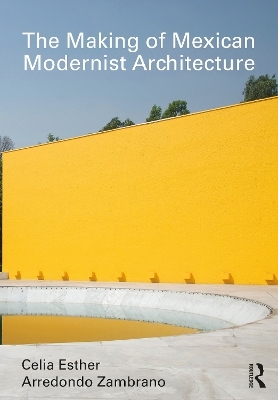
The Making of Mexican Modernist Architecture
Routledge (Verlag)
978-1-032-33277-2 (ISBN)
- Titel z.Zt. nicht lieferbar
- Versandkostenfrei
- Auch auf Rechnung
- Artikel merken
This book presents the making of Mexican Modernist architecture through five power structures – academic, social status, economic/political, gender, and postcolonial – and by interviews and analysis of 13 key Mexican architects. These include Luis Barragán, José Villagrán García, Juan O’Gorman, Pedro Ramírez Vázquez, Agustín Hernández, Abraham Zabludovsky, Carlos Mijares, Ricardo Legorreta, Juan José Díaz Infante, Enrique Norten, Alberto Kalach, Javier Sordo Madaleno and Clara de Buen.
Although the five power structures framed what was built, the testimony of these Mexican architects helps us to recognize and discover subtleties and nuances. Their views thereby shed light on what contributed to making Mexican Modernist architecture so distinctive globally. Even if these architects were not always aware of the power structures, their projects nonetheless supported discrimination, marginalization and subjugation. In that sense the book also reveals the extent to which these power structures are still present today.
The Making of Mexican Modernist Architecture’s uniqueness lies in uncovering the remarkable buildings that arose amid the five power structures while at the same time questioning their validity. It also voices the urgent need today for a new kind of architecture outside these boundaries. The book is essential reading for anyone studying Mexican and Latin American architecture.
Celia Esther Arredondo Zambrano was born in Monterrey, Mexico. She graduated from Tecnológico de Monterrey with a degree in Architecture, and has a master’s degree in Landscape Architecture from Texas A&M University and a master’s degree in Urban Design from Oxford Brookes University in England, where she later obtained her PhD in Architecture. She is Emeritus Professor at Tecnológico de Monterrey, Mexico and her areas of expertise are theory, history and cultural studies in architecture, as well as sustainable architecture and urban design. She has numerous publications in the fields of architecture, both in Spanish and in English. She was the first female president of the National Academy of Architecture, Chapter Monterrey, and was granted the status of Academic Emeritus, the highest distinction awarded by the National Academy of Architecture of the Mexican Architects Society.
1. Mexican Architecture as an Academic Discipline. Academic Discourse. Architectural Schools. Architectural Practice. The Role of Architectural Guilds and Associations. Architecture as a System of Meaning. Written Architecture. Architectural Classification Systems. Architectural Treatises. Photographed Architecture. Architects and their Authorship. The First Generation (1900–14). The Second Generation (1915–29). The Third Generation (1930–44). The Fourth Generation (1945–60). 2. Mexican Architecture and Economic and Political Power. Architecture and Power. Main Power Groups in Mexico. Twentieth-Century Mexican Economic Models. Influence of Economic Models on Twentieth-Century Mexican Architecture. Power in Twentieth-Century Architectural Modernism in Mexico. Hospitals. Museums. Hotels. Transportation Buildings. Banks. State Buildings. Private and Public Office Buildings. Public and Private Schools. Religious Architecture. 3. Mexican Architecture as Economic Status in a System of Consumption. Mexican Architecture and Consumption. Mexican Architecture as a Sign within the Consumption Cycle. The Image of Mexican Architects. Mexican Architects and their Social Status. Mexican Architects and their Social Image. Spatial and Social Marginalization in Mexico City. 4. Mexican Architecture and Gender. Mexican Architecture as a Gendered Discipline. Architecture an Artefact of Gender Differentiation. Women´s Place in Mexican Architecture. Men´s Place in Mexican Architecture. 5. Mexican Architecture and Postcolonialism. Mexico's Postcolonial Identity. Mimicry and Dissimulation. Hybridity and Simulation. Emotional Architecture or Magical Realism. 6. Epilogue
| Erscheinungsdatum | 17.04.2023 |
|---|---|
| Zusatzinfo | 4 Tables, color; 62 Line drawings, color; 133 Halftones, color; 195 Illustrations, color |
| Verlagsort | London |
| Sprache | englisch |
| Maße | 174 x 246 mm |
| Gewicht | 740 g |
| Themenwelt | Kunst / Musik / Theater ► Kunstgeschichte / Kunststile |
| Naturwissenschaften ► Biologie ► Ökologie / Naturschutz | |
| Sozialwissenschaften ► Ethnologie | |
| Sozialwissenschaften ► Soziologie ► Spezielle Soziologien | |
| Technik ► Architektur | |
| ISBN-10 | 1-032-33277-8 / 1032332778 |
| ISBN-13 | 978-1-032-33277-2 / 9781032332772 |
| Zustand | Neuware |
| Informationen gemäß Produktsicherheitsverordnung (GPSR) | |
| Haben Sie eine Frage zum Produkt? |
aus dem Bereich


